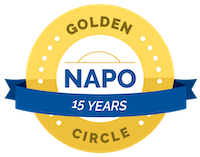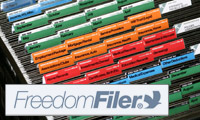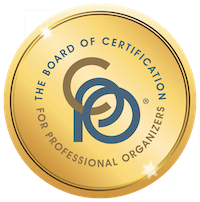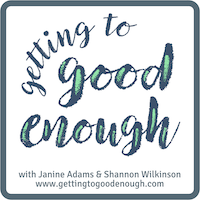Organizing your kitchen for the holidays
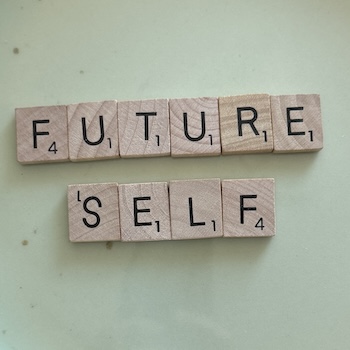
I was recently interviewed for the Ask Veronica column for St. Louis Magazine, an online column written by the magazine’s design editor and chief, Veronica Theodoro. The column, entitled Ask Veronica: The holiday season will be here before we know it. What steps can I take now to organize my kitchen?, allowed me to share some ideas for planning ahead to prepare your kitchen for holiday entertaining so that your gatherings are less stressful for you.
I’m a firm believer in helping out your future self by taking simple steps now to make potentially stressful events down the road easier. It can be hard to take the time to do that amidst the hustle and bustle of daily life. But if you do, your future self will thank you.
One way to do that is by hiring a professional organizer. When you make an appointment with an organizer (or organizing team) you make a time and financial commitment to help your future self. Whether it’s to plan for the holidays or a move, streamline your organizing systems, simplify your life by decluttering or anything else, working with a professional organizer allows you to actually get the job done (and maybe even have fun doing it). And that’s self care at its finest.
The ten things I know are true
I started Peace of Mind Organizing® in July 2005. When I made this big transition from being a writer, I strongly suspected it would bring me happiness. (You can read about why I became a professional organizer, if you’re interested.) What I didn’t know then is how much I would learn and what a life changing profession it is. On my tenth anniversary, I reflected on ten truths I’ve learned as an organizer. When I review those things after 19 years in business, I realize they’re as true as ever. I thought I’d share them again today.
Thinking about my anniversary, I took a moment to write down ten things I’ve learned as a PO that have been proven true over and over again.
- The less stuff you own, the easier your life is. Less stuff = more freedom.
- Relationships are more important than things. Don’t let your stuff get in the way of your relationships.
- There is no such thing as perfectly organized. Strive for “organized enough” instead.
- You can’t put something away unless you have a place for it. And you can’t have a place for it if you have more stuff than you can comfortably store.
- It’s easiest to create a new habit if you pair it with something you’re already doing. Use that trick to let habit creation be easy.
- Indecision leads to clutter. Make it a habit to decide immediately what to do with items.
- It’s okay to ask for organizing help. In fact, it can be very beneficial.
- Messy does not equal disorganized. I’m living proof.
- Tidy does not equal organized. I’ve seen many neat but disorganized spaces.
- You are not your stuff. Don’t let your stuff (and your ability to organize it) define you.
Alphabetizing my closet
I know this is going to sound crazy, but I organize my hanging clothes alphabetically. And it makes me so happy.
Let me explain. I buy almost all my clothes from one company, wool&. They sell merino wool clothes that I adore. They’re comfortable, durable and come in a variety of styles. I’ve blogged about the 100-day dress challenge I did four years ago as well as my love of merino clothes in the past.
wool& names all its garments. (Right now I’m wearing Roam, Axis and Cypress, along with a non-wool& merino sweater.) Since each wool& item that’s hanging in my closet has a name I can alphabetize them. I have two pairs of pants that I store together at the beginning of the rack. But all the other wool& garments are in alphabetical order.
It’s hard for me to take a photo in my closet because it’s narrow and I can’t back up far. But I just snapped this picture. Certainly the organization is invisible to the naked eye!
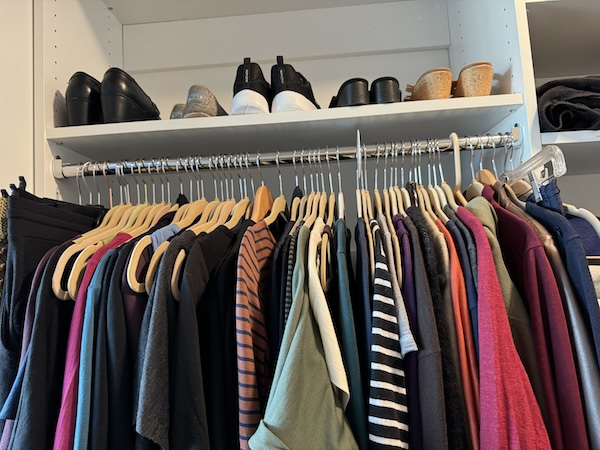
I don’t have a whole lot of clothes, which is how I like it. (All my hanging clothes fit on one 2.5-foot rod rod.) I just counted and I have 33 wool& garments plus 16 garments from other companies. A few of them are merino shirts or sweaters from other companies and most of the rest are clothes I bought at my favorite St. Louis charity shop, The NCJW Resale Shop plus one non-wool special-occasion outfit. The non-wool& clothes live to the right of a divider. The one exception is a favorite skirt that I knitted more than ten years ago. It’s the first garment on the rod because I enjoy looking at it when I open the closet door. (I do have a dresser drawer with leggings and bike shorts and another drawer with undergarments…they’re all wool too!)
The reason this works so well for me is that it works with how I think about my clothes. When I get dressed, I mentally put together an outfit. Since each part of the outfit has a name, it’s easy for me to find each component. When I take an item off the hanger, I leave the hanger in place to make it easy for me to hang it back up again.
Prior to alphabetizing my closet (which I did six months ago), I organized my closet by type of clothing (dresses, pants, jackets/cardigans). And back when I had more clothes I would organize them by color within those category. That worked with how I think as well.
There’s no right way to organize your clothes. And I know most people couldn’t (or wouldn’t want to) alphabetize their clothes. The best way to organize your closet, in my opinion, is to figure out how you think about your clothes and what would make it easy to find them and also to put them away. The way to keep a closet tidy is to put stuff away regularly. We all know that when we haphazardly put stuff in our closets it turns into an annoying mess quickly.
If you have a hard time finding the clothes you want to wear in your closet, I suggest going through them, letting go of the clothes that you don’t wear, and then thinking about how you go about selecting the clothes you do wear. Then perhaps you can revamp how you store them. It can be a fun exercise!
What you do first thing in the morning
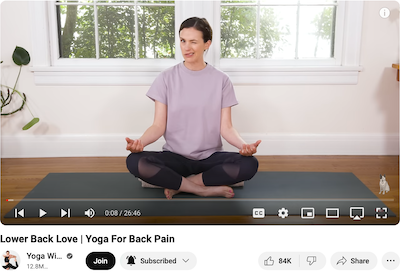
I feel like I’ve had to rework all my routines since we moved. Moving is just so disruptive!
One thing that fell by the wayside during the move and my husband’s hospitalization was my yoga practice. I had developed a consistent yoga practice after starting yoga six years ago. But when we moved in June I lost my yoga studio (which doubled as a seldom-used guest room). And I lost some privacy since at our old house my office and yoga studio were on the first floor and we lived on the second floor.
I’ve been waking up with a stiff back this past month or so and I know I would benefit from daily yoga. It was always on my mind but it just wasn’t happening. Then I did two things: I bought a second yoga mat to put under my current one so I could comfortably do yoga in my office. (Before, my yoga mat was on top of carpeting.) Initially my office seemed too small but I do have a yoga-mat-sized area I can practice in. The other thing I did was to make yoga the first thing I do after brushing my teeth in the morning (and playing Wordle and Strands).
I now proceed from the bathroom into my office (rather than into my kitchen) and start doing yoga immediately. It’s helping my back and it’s a great way to start the day. It feels so good to get this important activity accomplished first thing!
Is there something you’d like to be doing that you’re having trouble finding time for? Could you move it to the number one spot on your morning routine? You might find it’s a lot easier to accomplish that way!
Worth repeating (again): The beauty of vertical storage
I originally wrote this post in 2019. I moved earlier this year and all the photos in this post are from my old home. But I replicated the vertical storage in my new home whenever I could (which was most places). Five years later I’m still a big fan of vertical storage!
To the extent possible, I love storing things vertically, rather than horizontally. Think about how files are stored in a file cabinet—it’s much easier to access folders in a file cabinet than in a stack.
But vertical storage isn’t just for files. I love using the principle all around my house (and with clients). For my office supplies, for example, I have three shelves in my office supply closet where I store supplies vertically (see the photo below). Notice how my Post-it® notes and other supplies are stored vertically using acrylic containers (a divided one similar to this Linus 4-Section Drawer Organizer and a 4 × 12 × 3 Linus Deep Drawer Organizer) on a shelf. I used small containers inside a basket so help me store as much as I can vertically on the middle shelf of the photo. And on the shelf, this magazine sorter allows me to store clipboards and portfolios vertically. I repurposed a box from Bare Minerals so store a small collection of handy pouches.

I have some notebooks I like to keep handy on the radiator behind my desk. One of them is the one grab when I’m on the phone on a business call. By using a desktop file holder, I can store notebooks vertically so I can easily (and silently) grab the right one when I need it.

Long before Marie Kondo was telling us how to fold, I was folding my t-shirts in half again and storing them vertically in the drawer. I love that it enables me to see the shirts and just pluck out the one I want. I do the same thing with my leggings—I store them vertically and use this closet drawer organizer to keep them upright.
When you’re organizing in your home, I encourage you to think about how you might integrate vertical storage. I think you’ll find it life-enhancing!
Is it time to declutter your car?

My new car!
The lease on my Nissan Leaf is up and I’ve replaced it with a Nissan Ariya, another electric vehicle. (This one’s a slightly larger crossover, rather than a hatchback, and it’s a beautiful copper color.)
Before I turned in the Leaf I had to clean it out. I was surprised to see how much stuff I was storing in that car! It wasn’t cluttered—everything was put away. But it was like a clown car of little items!
The thing that struck me was that while my center console was admirably organized, I rarely if ever, accessed those items, with a few exceptions. And my glove box was crowded enough that sometimes I couldn’t find stuff when I was looking for it, even though it was in there.
I appreciated the opportunity to take a look at what I was storing in my car and decide what I really needed. Just like inside our homes, the more items we cram into a storage space, the harder it is to find anything. My new car’s center console has less storage (but it does have wireless phone charging!), so I was mindful in my choices. These are the things I elected to put back in the car:
- small first aid kit
- small manicure kit
- emergency automotive escape tool (something I hope I never use!)
- my husband’s disabled parking placard
- reusable grocery bag
- insurance card
- my NAPO-St. Louis name tag for chapter meetings
- small umbrella
- ice scraper
- hand-knit wastebasket (the one I had in my CR-V)
It took very little time to empty the car, sort the stuff and put back in what was needed. Since I returned so little to the car, I was able to put it away in no time. I once had the opportunity to help a client organize his car—he had more space and more stuff. I blogged about the process at the time, if you’re interested.
Helping democracy, one postcard at a time

Back in 2018, I signed up to write postcards to voters to help get out the vote. I did it through Postcards to Voters, an organization that gives you the opportunity to sign up for a postcard campaign and send postcards with prescribed messages to voters whose addresses you are sent. You must mail the number of postcards you selected within five days of asking for the addresses.
Between 2018 and 2024 I’ve sent over 4,000 postcards through this organization. I pay for the postcard and for the postage for each card and of course it takes some of my time. For me, it’s a great way to help get out of the vote since I don’t have to leave the house. It also helped me practice my hand lettering skills. (Postcards don’t have to look fancy, though. In fact you’re encouraged to make sure they look grassroots so they don’t want you to get fancy!)
This summer, I switched post-card writing organizations, which has streamlined the effort for me. I’m writing postcards through the group Postcards to Swing States. I signed up for two batches of 200 cards. The organization sent me the cards and the addresses and a choice of three messages to write on the card. Each batch of 200 is for voters in a specific state (in my case it’s Pennsylvania and Georgia) and each batch is to be mailed on a specific day in October. I supply the postage and, of course, my time.
Since this is a stressful summer for me, between moving and my husband’s health challenges, I needed to make postcard writing easier. The Postcards to Swing States route has worked out well. I try to do a batch night (or every other night). I have the message memorized and I don’t have to worry about running out of postcards. (And I was smart enough to order sufficient postcard postage stamps before the rate increase last month so I know I have enough stamps.) I keep a little kit containing everything I need on a shelf on the end table so I can easily pull it out when I sit on the couch. I usually write cards while I enjoy watching TV.
If you’re looking for some way to help during this election, you have legible handwriting and you enjoy writing by hand, I encourage you to check out either of these worthy organizations (and I’m sure there are others!). For me, it’s an easy way to do my part.
Edited to add: A day after posting this, I received an email from Postcards to Swing States that they have given out all 36 million addresses for the November election. If you’re interested in writing postcards, though, Postcards to Voters has ongoing campaigns.
Search
Recent Posts
- January 2025 tiny projects challenge: Day 5
- January 2025 tiny projects challenge: Day 4
- January 2025 tiny projects challenge: Day 3
- January 2025 tiny projects challenge: Day 2
- January 2025 tiny projects challenge: Day 1
- January 2025 tiny projects challenge!
- My word of the year for 2025: Flex
Tags
Links
- Ravelry
- Institute for Challenging Disorganization
- NAPO St. Louis
- Getting to Good Enough podcast
- Shannon Wilkinson, life coach
- National Association of Productivity and Organizing Professionals
- Are you interested in becoming a professional organizer?
- Peace of Mind Budgeting
- Organize Your Family History


